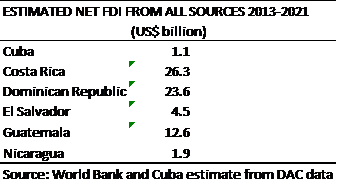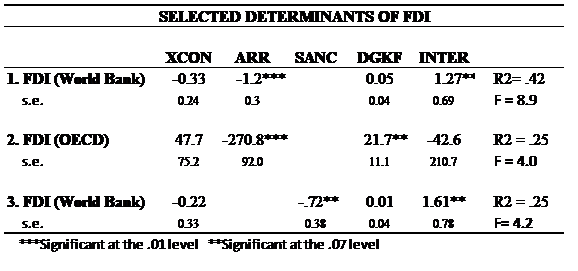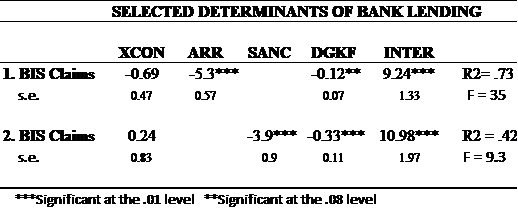DETERMINANTS OF RECENT FOREIGN INVESTMENT IN CUBA[1]
Luis R. Luis
The Cuban revolution has little love for foreign investment. The Cuban constitution after all leaves limited space for private capital. Nonetheless facing a shortage of capital, technology, and skills the Cuban government in recent years has strived to improve the legal and regulatory framework for foreign direct investment (FDI). The foreign investment law of 2014 and modified regulations in 2018 set the main rules for investors (Sanguinetty 2016, Gaceta Oficial 2018). Foreign investors can now have full ownership of operations without need of a joint venture with a local partner. Venues have opened for association with cooperatives and small firms while the government streamlines tax rules and tries to ease bureaucratic procedures. Surely the rules governing labor contracts remain onerous, and foreign trade and exchange operations are severely circumscribed. The government does not publish statistics on foreign investment as part of the balance of payments. The Cuban statistics agency ONEI published data on the number of approved foreign investment contracts with sadly no data on associated outlays (ONEI 2021). The minister of foreign trade mentioned that Cuba “attracted” foreign investments of $1.7 billion in 2019 and $1.9 billion in 2020 (Reuters 2020). These are commitments not disbursements. Commitments include domestically financed components and management contracts for hotels and other services not considered an inflow of FDI.
OECD and World Bank Data
The OECD provides data on net disbursements of FDI in Cuba by its most important members. These are the 29 countries in its Development Assistance Committee (DAC) and include the developed members of the European Union, the U.K., Switzerland, Norway, and Japan as well as the United States and Canada. The data comprises FDI originating directly in these nations. It does not include investments made through offshore centers such as Bermuda, the British Virgin Islands, the Cayman Islands and Panama where subsidiaries of multinational corporations operating in developing countries are often based. The OECD data therefore understates FDI from developed countries. Apart from providing evidence not available elsewhere of investment flows to Cuba, the data enables the comparison of investments in Cuba with those in other developing countries.
TABLE 1

Source: OECD, Geographic Distribution of Financial Flows to Developing Countries, 2015, 2020 and 2023.
Table 1 shows annual net direct investments in 2013-2021 from the OECD in Cuba and five other countries in the Caribbean basin, Costa Rica, Dominican Republic, El Salvador, Guatemala and Nicaragua. The five countries were selected based on their comparable economic size to Cuba and their geographic proximity. Net investments are volatile from year to year reflecting the lumpiness of investment projects, return of capital to source countries as well as economic and risk fundamentals. Net FDI also considers loan repayments to parent companies as return of capital. Occasionally, as in Costa Rica in 2020-2021, net outflows mask sizable inflows of FDI. Net FDI reflects changes in the investment balance sheet and is a measure of foreign investors’ risk exposure.
The World Bank uses balance of payments data to estimate yearly FDI flows from all sources. It does not publish data for Cuba. I estimate World Bank data for Cuba by using OECD statistics as an indicator. OECD net FDI comprises between 18% and 55% of total FDI for individual countries in our sample (excluding Costa Rica) as measured by the World Bank. I use the lower number as FDI in Cuba is more likely to be booked outside of the OECD. This results in a higher estimate for Cuban FDI. On this basis Cuba had net FDI of $1.1 billion in 2013-2021 or about 0.2% of GDP (Table 2). This means that investors keep risk exposure at a very low level by limiting equity capital in the island. It contrasts, for example, with the net flow of some $24 billion to the Dominican Republic, a country which also boasts a key tourism export sector.
TABLE 2

Determinants of FDI Variation
An attempt to explain the yearly variation of net FDI across countries is made with the aid of regression analysis, estimated from OECD (2021) and World Bank (2022) data on net FDI and IMF annual reports on exchange controls and payments restrictions (IMF 2021). Cuba’s World Bank FDI is based on the other five countries’ OECD average share of total FDI reported by the World Bank and is thus an estimate. Regressions below evaluate some of the determinants of FDI centering on risk variables. Analysis of FDI determinants is a widely explored topic in the literature (Nunnenkamp 2002, Walsh 2010). It comprises many dimensions of the topic including sectoral aspects of investments not considered here. Capital is expected to flow towards locations with higher risk-adjusted returns though it has long been observed that it often does not behave like that (Lucas 1990). By looking at six countries of comparable market size and regional proximity I forego from introducing directly these two important elements.
TABLE 3

Table 3 shows the results of analysis using panel data of selected determinants of FDI in the six countries in 2013-2019. FDI is net foreign direct investment to country i in year t obtained from World Bank and OECD statistics. World Bank FDI comprises the total net FDI received by a country while OECD FDI measures net flows from developed members of the OECD. XCON is an index for exchange controls on invisibles, transfers and capital transactions. ARR denotes the presence of arrears on foreign debt obligations of country i in year t. SANC denotes sanctions imposed to country i. DGKF is domestic gross capital formation (financed from national sources) as % of GDP, and it denotes conditions for domestic capital accumulation. ARR, SANC and XCON are variables expressing important elements of country risk. DGKF is an indicator of the ability of domestic institutions to provide a suitable investment environment. INTER is the intercept of the estimated equation.
The coefficients for ARR are statistically significant and as expected have a negative sign in equations 1 and 2. In equation 1 the presence of arears on a given year has a negative impact on net FDI of $1.2 billion while in equation 2 arrears lead to a fall of $270 million in flows from OECD countries. Coefficients for XCON are not significant. The coefficient for DGFK was significant with OECD data and shows a positive sign indicating complementarity between foreign and domestic investment. These results point to arrears as a sharp indicator of country risk.
What about the role of sanctions? Cuba as is well known has been under various U.S. sanctions including an embargo on trade since the early 1960’s. Restrictions on U.S. travel, remittances and trade payments were relaxed under the Barack Obama administration and then tightened again in the middle of the administration of Donald Trump. U.S. sanctions were also placed on Nicaragua during the Trump administration restricting international financing (U.S. Congress 2018). Long-standing laws ban investments in Cuba by U.S. entities. Firms in other countries fear that they will incur U.S. penalties or legal liability arising from U.S. laws and regulations. In addition, sanctions hit Cuban revenues from tourism and transfers raising foreign exchange and convertibility risk. It can be argued that in equations 1 and 2 the impact of sanctions is reflected in the presence or absence of payments arrears. This cannot be readily disentangled from other variables that underlie payments difficulties. As an alternative I run regressions with a variable for sanctions, SANC, substituting arrears. Two dependent variables are used with World Bank or OECD data. The coefficient of SANC is significant using World Bank FDI data (regression 3) but not with OECD data. The sanctions coefficient as expected has a negative sign. It indicates that a tightening of sanctions by 1 (the sanction variable was constructed to take values from 0 to 2) lowers annual FDI by $720 million. This is evidence of the impact of sanctions though the data shows that it derives from a hit to foreign investment after sanctions tighten in Nicaragua not Cuba. Cuban FDI flows remained very weak after the relaxation of sanctions by President Obama indicating the relevance of country risk and domestic policies.
Evidence from International Banking Data
It is long argued (Modigliani and Miller 1958) that firms under broad conditions are indifferent as to their capital structure between debt and equity. This arguably applies to firms’ international investment decisions regarding financing of foreign assets. The implication is that movements of equity and debt capital reflect common determinants. In practice this relationship is modified by institutional factors in financial markets and by the participation of governments in debt markets as lenders and borrowers. Nonetheless debt data can be used as a relevant cross-check of the relevance of determinants that affect FDI.
Table 4 shows results of regressions on the same determinants for the six countries in Table 1 using data from the Bank for International Settlements. The data represents claims by international banks reporting to the BIS on the six countries in 2013-2019. Using the same approach as in Table 1, two regressions were estimated, one with ARR and the other with SANC as independent variables. Both of these variables were statistically significant at the .01 level. The correlation of debt claims with gross domestic capital formation is stronger than for FDI. This provides evidence of the relevance of arrears and sanctions on the flow of debt capital to the countries in the sample. It suggests that arrears have a stronger negative impact on lending as compared to sanctions. This is not entirely surprising as contractual arrangements and bank policies provide less flexibility to deal with arrears compared to equity investors.
TABLE 4

Conclusions
This note looks at the recent evolution of foreign direct investment in Cuba and five neighboring countries with the aid of OECD and World Bank panel data. FDI net flows in Cuba in 2013-2021 are estimated at $1.1 billion or about 0.2% of GDP, well below announced contractual amounts and net flows to neighboring countries. Regression analysis provides evidence that debt payments arrears, an indicator of country risk, sharply affect FDI. Changes in sanction regimes towards Cuba and Nicaragua also impact net FDI, especially the second country. Arrears and sanctions as expected also impact debt capital flows. While recent legal and regulatory changes are a step forward, they are of limited avail without improved creditworthiness and eased economic rigidities and distortions.
APPENDIX ON DATA SOURCES
This appendix describes the sources of data for variables used in the regression analysis.
FDI (OECD) – Net disbursements of FDI from the Development Assistance Committee members of the OECD (OECD 2021). This includes data for all six countries in the regression analysis,
FDI (World Bank) – Net disbursements of FDI from all sources to five countries not including Cuba (World Bank 2022). Data for Cuba was estimated from FDI (OECD) using the average proportions of OECD net flows to World Bank flows.
XCON – Data for five countries obtained from IMF Annual Reports on Exchange Arrangements and Exchange Restrictions (IMF 2014-2021). XCON takes a value of 0 when there are no capital and current transaction controls on a given year. It takes a value of 1 when there are reported “capital controls” and 2 if there are also “surrender controls” on exports. Data for Cuba is derived from national sources.
ARR – Payment arrears as reported by the IMF (IMF 2014-2021). ARR takes a value of 0 when there are no arrears and 1 when those are presents. Cuba is well known to sustain payments arrears continuously since 1960 until the present.
SANC – These refer to US sanctions on trade and/or investments as stated in existing US legislation. A value of SANC of 0 indicates no sanctions, 1denotes sanctions on individuals and/or investments and trade, and 2 those in 1 plus restrictions on travel by US citizens.
DGKF – Domestic Gross Capital Formation minus net foreign investment as % of GDP as reported by the World Bank (World Bank 2022).
REFERENCES
Betancourt, R., 2013, “A Political Economy Approach to the Cuban Embargo.” ascecuba.org/blog, November 11.
Bloningen, B.A. and J. Piger, 2011, “Determinants of Foreign Direct Investment”. National Bureau of Economic Research, Working Paper 16704, January.
Brakman, S. and H. Garretsen, 2008, “Foreign Direct Investment and the Multinational Enterprise”. MIT Press, Seminar Series, March.
De Santis, G. and B. Gerard, 1997, “International Asset Pricing and Portfolio Diversification with Time-Varying Risk”. Journal of Finance, 52 (5).
Economist Intelligence Unit, 2020, “Cuba Seeks Relief from Paris Club Repayments”. May 28.
Federal Register, 2018, Executive Order 13851 of November 27, 2018.
Frank, M, “Cuba, Paris Club Reach a Deal to Skip 2021 Debt Payment.” Reuters, October 20, 2021.
French, J. and J. Poterba, 1991,”Investor No. 38, Investor Diversification and International Equity Markets”. American Economic Review, 81, 222-226.
Gaceta Oficial, 2018, Consejo de Ministros, Modificacion del Decreto No. 325, “Reglamento de la Ley de Inversion Extranjera, del 9 de abril de 2014.” No. 38 Extraordinaria.
Hellman, E., 2006, “Trade, Foreign Direct Investment and the Organization of Firms.” Journal of Economic Literature, Vol. XLIV, September, 589-630.
IMF, 2014-2021, Annual Report on Exchange Arrangements and Exchange Restrictions.
Lucas, R., 1990, “Why Capital Does Not Flow from Rich to Poor Countries.” American Economic Review, 80, (2), 92-96.
Luis, L., 2017, “Cuba’s Capital Account of the Balance of Payments.” Cuba in Transition, 27.
Luis, L., 2021, “The Aftermath of Monetary Reform in Cuba.” ascecuba.org/blog, November 16.
MINCEX, 2022, “Cartera de Oportunidades de Inversion Extranjera 2020-202.” https://www.mincex.gob.cu/files/16563487075fd10ef409b9d5.96035972.pdf
Modigliani, F. and Miller, M, 1958, “The Cost of Capital, Corporate Finance and the Theory of Investment.” American Economic Review, 48 (3)261-297.
Nunnenkamp, P., 2002, “Determinants of Foreign Direct Investment in Developing Countries: Has Globalization Changed the Rules of the Game?.” Kiel Working Paper No. 1122.
OECD, 2021, Geographical Distribution of Financial Flows to Developing Countries. www.oecd.org/dac.
ONEI, 2021, “Inversion Extranjera en Cuba. Indicadores Seleccionados.” Octubre. www. onei.gob.cu
Perez-Lopez, J.,2015, “Foreign Investment in Cuba’s ‘Updating’ of its Economic Model.” Cuba in Transition, 25.
Perez-Villanueva, O., 2002, “Cuba: An Overview of Foreign Direct Investment.” Carleton University, 2002.
Perez-Villanueva, O, 2016, “Foreign Direct Investment in Cuba: A Necessity and a Challenge” in Hershberg, E. and W. Leogrande (eds.) A New Chapter in US-Cuba Relations. Palgrave Macmillan.
Quazi, R., 2007, “Foreign Direct Investment in Latin America: A Panel Regression Study.” The International Journal of Business and Finance Research. Vol 1, 59-67.
Reuters, 2020, “Cuba attracts $1.9 billion in foreign investment despite U.S. sanctions, December 8.
Sabali, J. 1988, “A Practical Approach for Quantifying Country Risk.” Universia, (2)
Sanguinetty, J., 2016, “La Ley Cubana de Inversiones Extranjeras: Significado e Implicaciones.” Cuba in Transition, 26.
U.S. Congress, 2018, “Nicaragua Human Rights and Anticorruption Act of 2018.” H.R. 1918
Walsh, J. and J. Yu, 2010, “Determinants of Foreign Direct Investment: A Sectoral and Institutional Approach”. IMF Working Paper, July.
World Bank, 2022, https://data.worldbank.org/indicator/BN.KLT.DINV.CD?locations=C.
[1] I am indebted to John Devereux, Roger Betancourt and Ricardo Torres who made comments on an earlier version of this article.